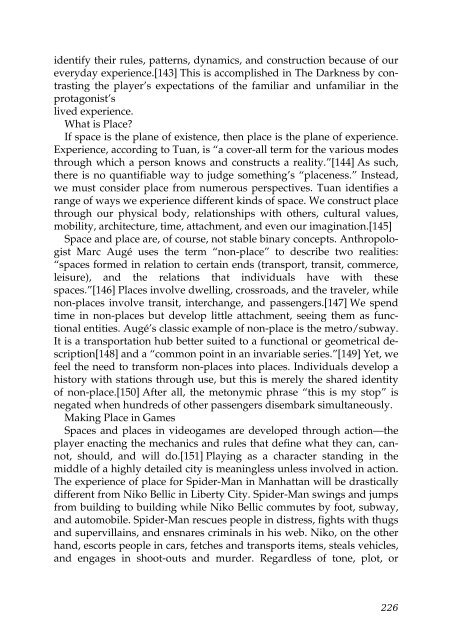Well Played 2.0: Video Games, Value and Meaning - OpenLibra
Well Played 2.0: Video Games, Value and Meaning - OpenLibra
Well Played 2.0: Video Games, Value and Meaning - OpenLibra
You also want an ePaper? Increase the reach of your titles
YUMPU automatically turns print PDFs into web optimized ePapers that Google loves.
identify their rules, patterns, dynamics, <strong>and</strong> construction because of our<br />
everyday experience.[143] This is accomplished in The Darkness by contrasting<br />
the player’s expectations of the familiar <strong>and</strong> unfamiliar in the<br />
protagonist’s<br />
lived experience.<br />
What is Place?<br />
If space is the plane of existence, then place is the plane of experience.<br />
Experience, according to Tuan, is “a cover-all term for the various modes<br />
through which a person knows <strong>and</strong> constructs a reality.”[144] As such,<br />
there is no quantifiable way to judge something’s “placeness.” Instead,<br />
we must consider place from numerous perspectives. Tuan identifies a<br />
range of ways we experience different kinds of space. We construct place<br />
through our physical body, relationships with others, cultural values,<br />
mobility, architecture, time, attachment, <strong>and</strong> even our imagination.[145]<br />
Space <strong>and</strong> place are, of course, not stable binary concepts. Anthropologist<br />
Marc Augé uses the term “non-place” to describe two realities:<br />
“spaces formed in relation to certain ends (transport, transit, commerce,<br />
leisure), <strong>and</strong> the relations that individuals have with these<br />
spaces.”[146] Places involve dwelling, crossroads, <strong>and</strong> the traveler, while<br />
non-places involve transit, interchange, <strong>and</strong> passengers.[147] We spend<br />
time in non-places but develop little attachment, seeing them as functional<br />
entities. Augé’s classic example of non-place is the metro/subway.<br />
It is a transportation hub better suited to a functional or geometrical description[148]<br />
<strong>and</strong> a “common point in an invariable series.”[149] Yet, we<br />
feel the need to transform non-places into places. Individuals develop a<br />
history with stations through use, but this is merely the shared identity<br />
of non-place.[150] After all, the metonymic phrase “this is my stop” is<br />
negated when hundreds of other passengers disembark simultaneously.<br />
Making Place in <strong>Games</strong><br />
Spaces <strong>and</strong> places in videogames are developed through action—the<br />
player enacting the mechanics <strong>and</strong> rules that define what they can, cannot,<br />
should, <strong>and</strong> will do.[151] Playing as a character st<strong>and</strong>ing in the<br />
middle of a highly detailed city is meaningless unless involved in action.<br />
The experience of place for Spider-Man in Manhattan will be drastically<br />
different from Niko Bellic in Liberty City. Spider-Man swings <strong>and</strong> jumps<br />
from building to building while Niko Bellic commutes by foot, subway,<br />
<strong>and</strong> automobile. Spider-Man rescues people in distress, fights with thugs<br />
<strong>and</strong> supervillains, <strong>and</strong> ensnares criminals in his web. Niko, on the other<br />
h<strong>and</strong>, escorts people in cars, fetches <strong>and</strong> transports items, steals vehicles,<br />
<strong>and</strong> engages in shoot-outs <strong>and</strong> murder. Regardless of tone, plot, or<br />
226

















